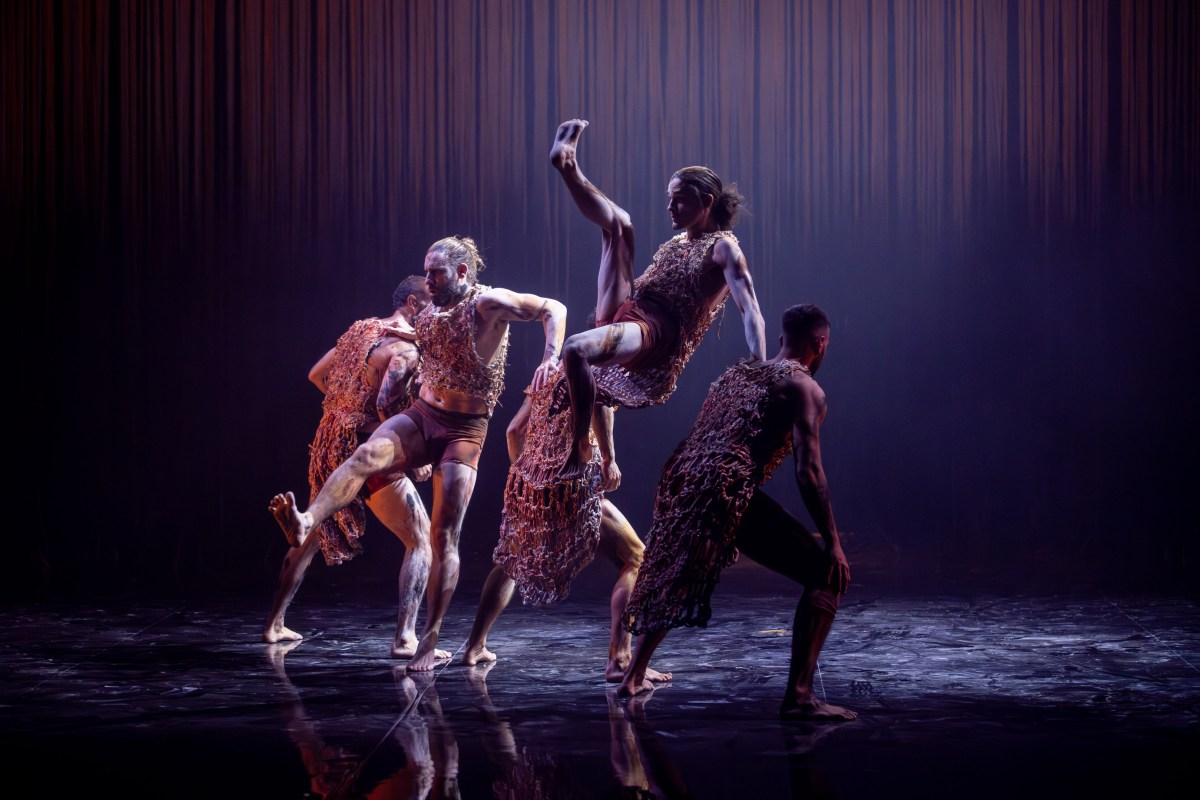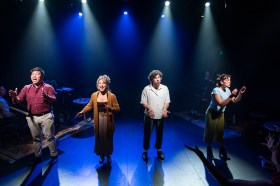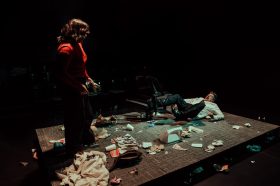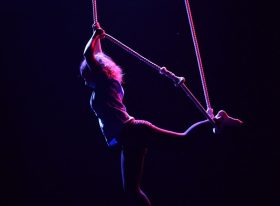In the arts community we often speak of having a connected practice, but it’s not often an idea that’s evident or easily executed. Bangarra Dance Theatre’s new production, Yuldea, is an embodiment of harmony between story, vision and being.
Yuldea tell the story of the Aṉangu of the Great Victorian Desert and the Nunga of the Far West region of South Australia. It’s simplified into the story of one site – a permanent clay pan waterhole on the lands of the Kokatha people with the traditional name of Yooldil Kapi. It is symbolised onstage at the intersection of trade, water and spiritual routes.
Yuldea is organised into four acts, that translate more as movements occurring in collusion between corporality, sight and sound.
- Act 1 – Supernova: Aṉangu clans observe the sky and its lore in relation to a supernova that gives them knowledge of a coming change.
- Act 2 – Kapi (Water): Drought forces people to travel long distances until they find the Yuldea Kapi piti.
- Act 3 – Empire: Letters Patent: 1836 King William IV issues a patent to proclaim a guarantee of the right of ‘any Aboriginal natives’ or their descendants to lands they ‘now actually occupied or enjoyed’. Steel Snake: Construction begins on the Trans Australian Railway. Black Mist: The Australian Government begins atomic testing at the site known as Maralinga.
- Act 4 – Ooldea Spirit: In spite of the impacts of colonisation, kinship ties connect people to Country and land to sky, reflected overhead by Kapi, a divine Songline linking earth and sky.
Choreographed by Bangarra veteran and new Artistic Director, the multi award-winning Frances Rings, this is a physical story that comes up out of the ground to dance in the sky. As a Wirangu and Mirning woman, Rings draws from her place on Country in an exercise of reflexivity, fluidly moving Bangarra into this new era under her directorship. Part of the genius of this work is an incessant movement that shuns stillness, yet is still capable of communicating silences interspersed by a diversity of violence. The whole work is an exercise in choreographic mastery.
Winding, twisting, crawling, reaching and transforming, the cast of Yuldea have rehearsed to such a point that they are able to move as one undulating whole, without the ego or the overt consciousness of the self that is performed in other spaces.
Seamlessly constructed with aerial and acrobatic creative consultant Joshua Thomson, the performance arena embodies the themes by making use of the horizontal and vertical space, and utilising tools like bungee cords from physical theatre. The other side of this equation are the dancers who time and time again evoke an organic kinesis. A special mention has to be made of dancers Lillian Banks and Kallum Goolagong, whose precision and amplitude as the Kapi Spirits in Act Two was something I have rarely seen performed. As with the rest of the dancers, not a foot or a spirit is out of place. The commitment and responsibility to the story is almost that of spiritual ceremony, where you step out and let the ancestors use you.
The set designed by Elizabeth Gadsby is formed principally of two arcs. One of them is the aerial representation of the Songline – a giant glowing, almost rib-like sculpture. The other is a gathering of cords forming the permeable boundary around the interior stage. Married with Karen Norris’ lighting design, the result is a sculptural simplicity that acts in concert with all other elements of this production to create an aesthetic that’s highly stylised, functional and understated.
The costume design by Jennifer Irwin must also be mentioned in terms of its role in storytelling. Organic and asymmetrical, the fabric choices, colour and movement of these pieces are all breathtaking. Every piece is a sculptural exemplar in its own right.
It’s challenging to speak about the individual elements of this production, as it is obviously a culmination of the love of many. The music and soundscapes that rise up around the audience are from Composer, Leon Rodgers and Guest Composers, Electric Fields. With cultural consultation provided by Maureen Smart, the whole production is clearly the creation of a grounded, cohesive team, meaning Yuldea is a product of the whole.
Read: Dance review: STATE, State Theatre Centre of WA
This is a time when Australia is struggling to know itself and to acknowledge the role that we play in the daily cultural violences enacted upon our First Nations People. There is no greater tool than storytelling to create understanding, and to share knowledge with those who are willing to listen. Yuldea uses the stage to show how decisions made by disconnected others have the power to change the landscape forever. It’s a story the moral of which should not be taken lightly.
Yuldea
Bangarra Dance Theatre
Sydney Opera House
Choreographer: Frances Rings
Set Designer: Elizabeth Gadbsy
Costume Designer: Jennifer Irwin
Lighting Designer: Karen Norris
Composer: Leon Rodgers
Guest Composers: Electric Fields
Mirning Cultural Consultant: Clem Lawrie
Yalata Cultural Consultant: Maureen Smart
Cultural Astronomer: Karlie Noon
Cultural Authority: Representatives from the Yalata Aṉangu Aboriginal Community Council
Aerial and Acrobatic Creative Consultant: Joshua Thomson
Yuldea will be performed until 15 July 2023 in Sydney before touring to Canberra, Adelaide, Brisbane, Melbourne and Bendigo.





